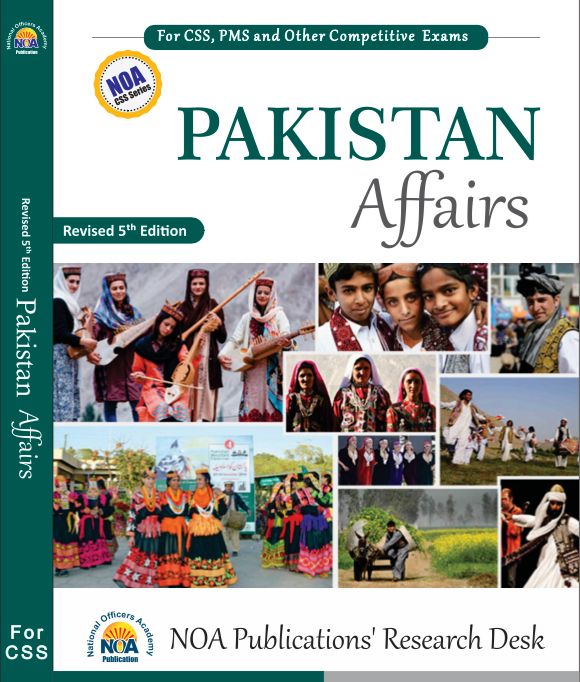Pakistan Affairs By Sir Hassan Ali Gondal (NOA Publication)
Best For Competitive Exams (CSS,PMS ,PCS & All Descriptive Exams)
PREFACE
Compilation of a book on Pakistan Affairs is a very demanding task keeping in view the complex nature of the subject and involvement of sensitive multi-dimensional variables. In a globe undergoing constant and rapid change, it is imperative to accurately describe, explain, and predict the key events and issues unfolding in national affairs and affecting the future of our great nation. Only informed interpretations of national conditions and trend trajectories and cogent explanations of why they exist and how they are unfolding can provide the tools necessary for understanding the subject. By presenting the leading ideas and the latest information available, this book provides the tools necessary for understanding Pakistan Affairs in our present period of history, for anticipating probable developments and for thinking critically about the potential long-term impacts of those developments on our country.
Based on the rationale that books available on Pakistan Affairs do not cover the range of syllabus in totality, the need was felt to introduce a book from the platform of NOA Publications which cover all topics in a comprehensive manner along analytical perspective. NOA Publications' Research Desk compiled this book from best references including books, journals' publications, conference proceedings, research reports, Op-Eds, policy briefs, statistical reports and general commentaries. Based on authentic sources, this book, arguably, shall serve as a single source for holistic preparation of the subject and develop analytical perspectives in concurrence.
I feel humbled and pay my gratitude to all my team members including Mr. Syed Wajeeh ul Hassan, Ms. Sadaf Qayyum and Ms. Maryam Fatima. Without their efforts, completion of this book and the goal of maintaining its quality was not possible to achieve. I am also thankful to all those who, directly or indirectly, contributed by sharing their valuable ideas and suggestions regarding book preparation. I, on behalf of my team, extend my heartiest gratitude to our parents, teachers, colleagues and family members. I am also thankful to those who appreciated this effort and encouraged a lot during this exercise especially, all faculty members of the subject in National Officers Academy. Lastly, I pay my regards to Dr. Muhammad Atif Ali (CEO, National Officers Academy) and Mr. Muhammad Tahir for their non-relinquishing patronage of my team. Without their commitment towards the cause, it was not possible for us to move even a single step. I wish and pray that this book enlightens the students with the best knowledge gathered at one place. Fruitful suggestions to improve the contents will be highly appreciated.
H A Gondal
Research Team Lead
Editor-in-Chief
NOA Publications
SYLLABUS
Chapter ~ I ~
Chapter ~ II ~
· Ideology of Pakistan definition and elucidation, historical aspects: Muslim rule in the Sub-Continent, its downfall and efforts for Renaissance. Movements for reforms Shaikh Ahmad Sarhindi, Shah Waliullah, Sayyid Ahmad Shaheed, Aligarh, Deoband, Nadwah, and other educational institutions- Sindh Madrassah and Islamia College Peshawar, Ideology of Pakistan in the light of Speeches and statements of Allama Iqbal and Quaid-i-Azam Muhammad Ali Jinnah.
Chapter ~ III ~
· Land and people of Pakistan ----- Geography, Society, Natural Resources, Agriculture, Industry and education with reference to characteristics, trends and problems.
Chapter ~ IV ~
· Pakistan and Changing Regional Apparatus.
Chapter ~ VI ~
· Nuclear Program of Pakistan, its Safety and Security; International Concerns.
Chapter ~ IV ~
· Regional Cooperation Organizations (SAARC, ECO, SCO and the Role of Pakistan.
Chapter ~ VII ~
· Civil-Military Relations in Pakistan
Chapter ~ IX ~
· Economic Challenges in Pakistan
Chapter ~ VI ~
· Non-Traditional Security Threats in Pakistan: Role of Non-State Actors
Chapter ~ IV ~
· Pakistan’s Role in the Region
Chapter ~ VIII ~
· The Palestine Issue
Chapter ~ VI ~
· Changing Security Dynamics for Pakistan: Challenges to National Security of Pakistan.
Chapter ~ VII ~
· Political Evolution Since 1971
Chapter ~ VIII ~
· Pakistan and US War on Terror
Chapter ~ VIII ~
· Foreign Policy of Pakistan Post 9/11
Chapter ~ VII ~
· Evolution of Democratic System in Pakistan
Chapter ~ VII ~
· Ethnic Issues and National Integration
Chapter ~ VI ~
· Hydro Politics; Water Issues in Domestic and Regional Context
Chapter ~ VI ~
· Pakistan’s National Interest
Chapter ~ VI ~
· Challenges to Sovereignty
Chapter ~ VI ~
· Pakistan’s Energy Problems and their Effects
Chapter ~ V ~
· Pakistan’s Relations with Neighbors excluding India
Chapter ~ V ~
· Pakistan and India Relations Since 1947
Chapter ~ V ~
· The Kashmir Issue
Chapter ~ V ~
· The war in Afghanistan since 1979 and its impact on, and challenges to Pakistan in the Post 2014 ear.
Chapter ~ VI ~
· Proxy Wars: Role of External Elements.
Chapter ~ IX ~
· Economic Conditions of Pakistan, the Most Recent Economic Survey, the Previous and Current Budgets, and the Problems and Performance of Major Sectors of Economy.
Chapter ~ VII ~
· The Recent Constitutional and Legal Debates, the Latest Constitutional Amendments and Important Legislations, Legal Cases and the Role of Higher Courts.
Chapter ~ VI ~
· The Prevailing Social Problems of Pakistan and the Strategies to Deal with Them, Poverty, Education, Health and Sanitation.
CONTENTS
Chapter-I- Story of Muslim Rise & Fall in Sub-Continent
A Cradle of Ancient Civilization.
v Pakistan's Amazing Historical Background
Advent of Muslims in Sub-Continent
v Trading Relations - First Interaction
v Muhammad Bin Qasim (695-715)
v Mahmud Ghaznavi (971-1030)
v Ghauris (1148-1206)
v Slave Dynasty (1211-1290)
v Khilji Dynasty (1290-1320)
v Tughluq Dynasty (1320-1413).
v Saiyid Dynasty (1414-1451).
v Lodhi Dynasty (1451-1526).
The Mughal Empire (1526-1857).
v Establishment of Mughal Empire: (Babur)
v Humayun (1530-1539).
v Akbar the Great (1556-1605)
v Jahangir (1605-1628)
v Shah Jehan (1628-1658)
v Aurangzeb (1658-1707).
v Bahadur Shah Zafar (1775-1862)
v Decline of the Mughal Empire.
Causes of Muslim Downfall
v Downfall Tsunami of Multiple Factors.
British Arrival & Rise to Power
v British East India Company (1600)
v The Sikh Empire (1799-1849)
v War of Independence, 1857.
v Muslims after War
Impact of Islam in India
v Islam Shaped a New Order.
v Religion and Sufism
v Prominent Sufi Orders in Sub-Continent
A Cradle of Ancient Civilization
Ø Pakistan's Amazing Historical Background
Pakistan's history goes back a really long time, even before a few centuries ago. It all started with ancient civilizations. The story of Pakistan goes back to when early humans, like us, left Africa and settled in this region as the first coastal migration route. The rural life in South Asia, which lasted for about nine centuries, can be traced back to a place called Mehrgarh in Balochistan, Pakistan. The urban life in South Asia, which lasted for five centuries, can be seen in places like Harappa in Punjab and Mohenjo daro in Sindh, both in Pakistan. Mehrgarh, located in the plains of Balochistan, saw people change from being hunters to farmers and herders. When we say Pakistan is the home of ancient civilizations, it means that the country has a rich history with diverse landscapes, interesting culture, pleasant weather, and many archaeological and historical sites. Pakistan was the birthplace of two major ancient civilizations: the Indus Valley civilization and the Gandhara civilization.
· The Indus Valley Civilization
The Indus Valley civilization, also known as the Harappan civilization, started and grew in what is now Pakistan from 3300 to 1300 BCE. It was one of the largest civilizations, with two older civilizations being the Mesopotamian and Egyptian civilizations. Anthropologists call the Indus civilization the Bronze Age because of the archaeological discoveries in the region. The Harappan civilization had a population of up to five million people. The first excavations of the Harappan civilization happened accidentally in 1921 at Harappa, and later in 1922 at Mohenjo Daro. These excavations showed that the Indus civilization had major cities like Harappa, Mohenjo Daro, and Ganeriwala in present-day Pakistan, and other cities like Dholavira, Lothal, and Kalibangan in present-day India. There were also over one hundred villages in the rural areas.
Mohenjo Daro, which was developed around 2600 BCE, is believed to be the earliest planned urban settlement with advanced engineering. Harappa had a well-organized administration and religious centers were important in the society. Both cities had proper town management, including systems for drainage, water supply, waste collection, well-planned roads, and transportation. The architecture included buildings made of baked and sun-dried bricks, large forts, furnaces, public baths, and big storehouses. The excavations from the Indus Valley have shown that the people were literate and their language is identified as Dravidian. They used standard weights and practiced burying the dead, which was a new practice at that time. They were skilled at using wheels for transportation and they built boats for trade. The artifacts and writings found at these sites show that the people of the Indus civilization developed new techniques for working with metals like lead, tin, copper, and bronze. Skilled craft workers made sculptures, pottery, jewelry, and seals using materials like clay, gold, and seashells. They were particularly famous for their seal carving, and the seals had animal figures on them. There is evidence that they used semi-precious gems and stones in their handicrafts.

